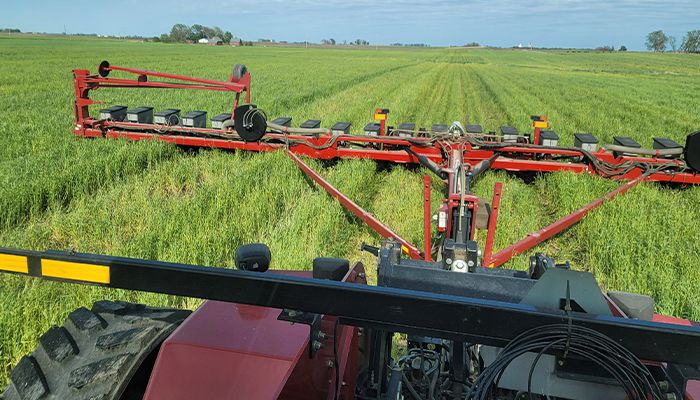Bardoles embrace generations of conservation
Author
Published
3/31/2025
Greene County farmers find conservation practices like cover crops and reduced tillage result in lower fuel usage and improve soil health.
While successful farm management involves plenty of must-dos, the Bardole family has also embraced a list of “don’ts” on their Greene County farm. Don’t cultivate. Don’t disk. Don’t burn all that diesel fuel.
“Our fuel bill is about half of what it used to be,” said Tim Bardole, 57, who farms in the Rippey area with his brother, Pete, their father, Roy, and their sons.
Then there’s the increase in organic matter (OM) connected to reduced tillage, added Roy Bardole, 81. “Every tillage pass costs you a fourth of an inch of moisture, but every additional percentage of OM lets your soil hold an additional inch of rain. This is huge in dry years.”
This less-is-more philosophy translates into higher profit potential. “I’d put our yields up against anyone’s,” said Tim Bardole, a past president of the Iowa Soybean Association (ISA) and a United Soybean Board director.
His son Schyler, 31, often uses the Snapchat social media app to provide updates from the field.
“While some farmers say they can’t stand the look of no-till, I liked the look of 270 bushels per acre last fall,” he said.
Strip-till and no-till, combined with cover crops, have transformed the Bardoles’ soil through the years.
“Soil is resilient, once you get soil health working for you,” Tim Bardole said. “People tend to underestimate the benefits and flexibility that healthy soil gives you.”
This includes better water infiltration, which helps reduce runoff and erosion. Consider a field that the Bardoles farm near Grand Junction.
“On our side of the fence, we had some drowned-out spots, but they were small and narrow by the fenceline,” said Pete Bardole, 58. “The land on the other side of the fence was a pond. A view from Google maps even showed this.”
Improved soil health also means less soil compaction, which allows for better plant growth.
“Our banker couldn’t believe how amazing our soil structure is compared to some of his other customers’ fields,” said Pete Bardole, a Greene County supervisor. “This soil structure lets us get back into the field two days earlier after a rain, compared to farmers who use more tillage.”
Seeing is believing
Learning from the land is important to the Bardole family. Those lessons took root with Roy Bardole when he rode with his uncle Howard Bardole on his milk truck route in the 1950s.
“Back then, farmers plowed their fields black. When strong winds would blow, it wasn’t usual for 6 to 7 inches of dirt to end up in the ditch over time.”
Roy Bardole also recalled a soil lesson from one of his ag classes at Rippey High School.
“One soil sample had been plowed and was slabbed over, while the other sample came from an alfalfa field. We poured water on both samples until they were supersaturated. Then we checked them the next morning. The soil from the alfalfa field had a crumbly structure, but the slabbed soil ended up more like puddle.”
Those lessons stuck with Roy Bardole when he began farming full-time in 1965. When the ISA sponsored a meeting in Ames in the early 1980s about no-till, he was inspired by the research.
“It showed that a hill that was plowed had massive runoff — a complete contrast from the no-till acres,” he said. “I figured if I could do something similar to hold more of the water on the land, that would be a really good thing.”
Adopting no-till didn’t come without a social cost.
“A lot of neighbors thought I was a lunatic,” he noted.

PICTURED ABOVE: The Bardoles plant some of their acres into cover crops, which help slow erosion, suppress weeds and improve soil health. PHOTO CONTRIBUTED
The most valuable asset
Undeterred, Roy Bardole gained experience with reduced tillage and no-till. He also appreciated modern herbicides, which made no-till more viable.
Thanks to his roles as president of ISA and chairman of the U.S. Soybean Export Council, Roy Bardole shared his experiences with farmers across the country.
He also reached a wider audience, including the Smithsonian Institute, and addressed the U.S. Commission on Ocean Policy, which was studying agricultural practices and water pollution.
“Soil in the field is a farmer’s most valuable asset,” Roy Bardole said. “As soon as it moves out of the field, however, it’s dirt — and that’s a pollutant.”
While all this would be enough to convince the Bardoles that conservation pays, it’s also simple math, Schyler Bardole said.
“Less tillage is just more profitable. I don’t have a disk, a ripper or a cultivator, and I’m more efficient. Your time is worth a lot.”
Maulsby is a freelance writer from Lake City.
Want more news on this topic? Farm Bureau members may subscribe for a free email news service, featuring the farm and rural topics that interest them most!